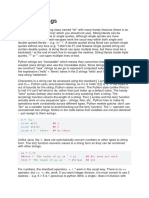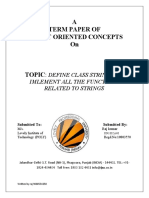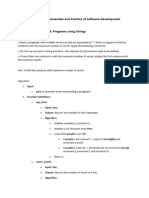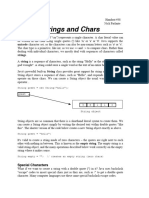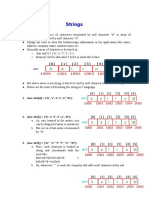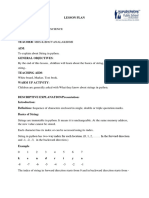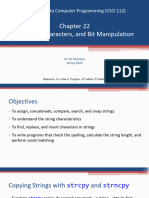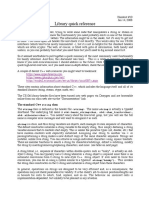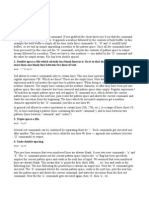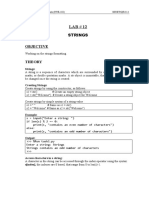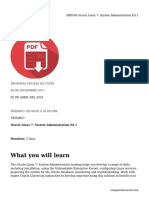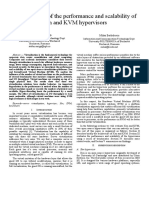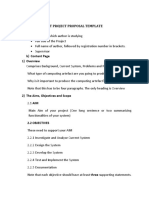Ruby On Rails Simple Examples & Strings
Ruby On Rails Simple Examples & Strings
Uploaded by
Sumanth KrishnaCopyright:
Available Formats
Ruby On Rails Simple Examples & Strings
Ruby On Rails Simple Examples & Strings
Uploaded by
Sumanth KrishnaOriginal Title
Copyright
Available Formats
Share this document
Did you find this document useful?
Is this content inappropriate?
Copyright:
Available Formats
Ruby On Rails Simple Examples & Strings
Ruby On Rails Simple Examples & Strings
Uploaded by
Sumanth KrishnaCopyright:
Available Formats
Ruby on Rails : Strings
Today we will look into few examples and introduce on strings with working examples.
Say we start on simple math factorial function
The mathematical definition of n factorial is:
n! = 1 (when n==0)
= n * (n-1)! (otherwise)
In ruby, this can be written as:
def factorial(n)
if n == 0
1
else
n * factorial(n-1)
end
end
You may notice the repeated occurrence of end.
(Note: the syntax of ruby more closely mimics that of a language named Eiffel.)
You may also notice the lack of a return statement. It is not needed because a ruby
function returns the last thing that was evaluated in it. Though use of a return statement
is permissible but it is not necessary here.
Let's try out our factorial function. Adding one line of code gives us a working program:
# Program to calculate the factorial of a number
# Save this as factorial.rb
def factorial(n)
if n == 0
1
else
n * factorial(n-1)
end
end
print factorial(ARGV[0].to_i), "\n"
ARGV is an array which contains the command line arguments, and to_i converts a
character string to an integer.
1 Prepared By: Sumanth Krishna. A
Ruby on Rails : Strings
Experiment:
What happens if I pass string as argument instead of integer?
At the line “12”, replace the double quote with single quote and see what happens?(It
will be discussed in next page)
2 Prepared By: Sumanth Krishna. A
Ruby on Rails : Strings
A String object holds and manipulates an arbitrary sequence of bytes, typically
representing characters. String objects may be created using String::new or as literals.
Because of aliasing issues, users of strings should be aware of the methods that modify
the contents of a String object.
• Methods with names ending in ``!’’ modify their receiver.
• Methods without a ``!’’ return a new String.
Ruby deals with strings as well as numerical data. A string may be double-quoted ("...")
or single-quoted ('...').
• A double-quoted string allows character escapes by a leading backslash, and the
evaluation of embedded expressions using #{}.
• A single-quoted string does not do this interpreting; what you see is what you get.
Examples:
If you had done the above mentioned experiments, it is easy to understand the above two
points. The difference between the double and single quotes around a string. There are
plenty of methods that ruby offers, they come very handy!
capitalize:
str.capitalize => new_str
This method turns the first letter of the string to upper case.
"hello".capitalize #=> "Hello"
Ruby
chomp:
str.chomp(separator=$/) => new_str
Returns a new String with the given record separator removed from the end of str (if
present). If $/ has not been changed from the default Ruby record separator, then chomp
also removes carriage return characters (that is it will remove \n, \r, and \r\n).
"ruby\r\n".chop #=> "string"
"ruby\n\r".chop #=> "string\n"
3 Prepared By: Sumanth Krishna. A
Ruby on Rails : Strings
In Ruby, strings are mutable. They can expand as needed, without using much time and
memory. Ruby stores a string as a sequence of bytes.
insert:
str.insert(index, other_str) => str
Inserts other_str before the character at the given index, modifying str. Negative indices
count from the end of the string, and insert after the given character. The intent is insert
aString so that it starts at the given index.
"abcd".insert(0, 'X') #=> "Xabcd"
"abcd".insert(3, 'X') #=> "abcXd"
length:
str.length => integer
Returns the length of str.
"ruby". length #=> 4
"ruby on rails". length #=> 13
ljust:
str.ljust(integer, padstr=' ') => new_str
If integer is greater than the length of str, returns a new String of length integer with str
left justified and padded with padstr; otherwise, returns str.
"hello".ljust(4) #=> "hello"
"ruby".ljust(20, '1234') #=> "ruby1234123412341234"
strip:
str.lstrip => new_str
Returns a copy of str with leading whitespace removed.
" hello ".lstrip #=> "hello "
"hello".lstrip #=> "hello"
str.rstrip => new_str
Returns a copy of str with tailing whitespace removed.
" hello ".lstrip #=> " hello"
replace:
str.replace(other_str) => str
Replaces the contents of str with the corresponding values in other_str.
s = "java" #=> "java"
s.replace "Ruby" #=> "Ruby"
reverse:
str.reverse => new_str
Returns a new string with the characters from str in reverse order.
"stressed".reverse #=> "desserts"
4 Prepared By: Sumanth Krishna. A
Ruby on Rails : Strings
Methods with names ending in ``!’’ modify their receiver.
capitalize!:
str.capitalize! => str or nil
Modifies str by converting the first character to uppercase and the remainder to
lowercase. Returns nil if no changes are made.
a = "hello"
a.capitalize! #=> "Hello"
a #=> "Hello"
a.capitalize! #=> nil
Following is the list of methods that ruby supports for the String Class.
Experiment:
% , *, +, <<, <=>, == , =~, [], []= ,
block_scanf, capitalize , casecmp, center, chomp, chop, concat, count, crypt,
delete, downcase, dump, each, each_byte, each_char, each_line, hash , hex,
index, initialize_copy, end_regexp, gsub, insert, inspect, intern, issjis, isutf8,
jcount, jlength, jsize, kconv, length, ljust, lstrip , iseuc, replace, reverse, Oct,
quote , match , New, next, rindex, rjust, rstrip, scan, scanf, size, slice, split,
squeeze, squeeze, strip, sub, sum, swapcase, unpack, upcase, upto, yaml_new
chomp!, capitalize!, chop!,delete!, downcase!, gsub!, lstrip!, next!, reverse!, rstrip!,
slice!, upcase!,
empty?, eql?, include?, is_binary_data?, is_complex_yaml?, mbchar?,
squeeze!, squeeze!, strip!, sub!, succ, succ!, swapcase!,
to_f, to_i, to_s, to_str, to_sym, to_yaml toeuc tojis tosjis toutf16 toutf8 tr
tr, tr!, tr!, tr_s, tr_s!,
References:
Ruby String Class: http://ruby-doc.org/core/classes/String.html
5 Prepared By: Sumanth Krishna. A
You might also like
- Functionality of Brain - Awesome AnalogyDocument10 pagesFunctionality of Brain - Awesome AnalogySumanth Krishna100% (2)
- Ruby Cheat SheetDocument7 pagesRuby Cheat Sheetcortfr100% (73)
- Clock Gating Lab NotesDocument7 pagesClock Gating Lab NotesRajesh Mangalore AnandNo ratings yet
- Ruby On RailsDocument99 pagesRuby On RailsDeepa AcharyaNo ratings yet
- Python Strings: S S Len(s) S+Document3 pagesPython Strings: S S Len(s) S+AnandNo ratings yet
- Regular Expression 01Document48 pagesRegular Expression 01Aamna RazaNo ratings yet
- Old Course Notes StringsDocument7 pagesOld Course Notes StringsJeremy UyNo ratings yet
- Лекция RubyDocument15 pagesЛекция Rubyx86d0centNo ratings yet
- Term Paper On String C++Document23 pagesTerm Paper On String C++Raj ShahNo ratings yet
- Strings: Dept. of Computer Science Faculty of Science and TechnologyDocument13 pagesStrings: Dept. of Computer Science Faculty of Science and Technologymonstea eanNo ratings yet
- Strings AssignemntDocument12 pagesStrings Assignemntsakthivel222sanjayNo ratings yet
- HO38 StringDocument10 pagesHO38 Stringfabrizio8881No ratings yet
- Adobe Scan Oct 17, 2024 (2)Document24 pagesAdobe Scan Oct 17, 2024 (2)singhharsh2485No ratings yet
- Ruby Cheat SheetDocument6 pagesRuby Cheat Sheetursu_padure_scrNo ratings yet
- Fall 23-24lecture 6 StringDocument13 pagesFall 23-24lecture 6 Stringfardinmojumdar123No ratings yet
- String_RDocument6 pagesString_RRAHUL SHARMANo ratings yet
- ICT582Topic03Document40 pagesICT582Topic03Hammad anwarNo ratings yet
- 4.1. StringsDocument6 pages4.1. StringsManoj ManojNo ratings yet
- Python StringDocument42 pagesPython Stringrishavrivals23No ratings yet
- Ruby Cheat SheetDocument5 pagesRuby Cheat SheetRene William Uemura SchneiderNo ratings yet
- WT Unit 6 NOTESDocument78 pagesWT Unit 6 NOTESmuskanofficial0304No ratings yet
- Lab Report 10 Background Theory and ConclusionDocument3 pagesLab Report 10 Background Theory and ConclusionRyu KenNo ratings yet
- FinalprintslDocument44 pagesFinalprintslsimhachowdary234No ratings yet
- SET - 11 (String Basic)Document12 pagesSET - 11 (String Basic)MUKUL MANDLOINo ratings yet
- 13B RegExpDocument38 pages13B RegExpodiezeani1No ratings yet
- Cheats Hee TenDocument14 pagesCheats Hee Tenspleen-5230No ratings yet
- 01.VB Script - Part IDocument9 pages01.VB Script - Part IVenkataramana SamaNo ratings yet
- UntitledDocument53 pagesUntitleddfgdfgNo ratings yet
- 6 StringDocument11 pages6 Stringbhuvanalakshmi kNo ratings yet
- Regular Expressions: Regular Expression Syntax in PythonDocument11 pagesRegular Expressions: Regular Expression Syntax in PythonHa NguyenNo ratings yet
- Roots in RubyDocument4 pagesRoots in RubyJabari ZakiyaNo ratings yet
- Chapter 11Document10 pagesChapter 11alysonmicheaalaNo ratings yet
- Chapter 22Document21 pagesChapter 22maryam osamaNo ratings yet
- VB Script - Part I: ChaptersDocument6 pagesVB Script - Part I: Chaptershaibye424No ratings yet
- Perlre Perl Regular ExpressionsDocument16 pagesPerlre Perl Regular Expressionsfippifuppi78No ratings yet
- 08-C - StringsDocument9 pages08-C - StringsAshish JindalNo ratings yet
- Sololearn Ruby LanguageDocument32 pagesSololearn Ruby LanguageSagar SikchiNo ratings yet
- 3.string Slicing and Other Functions in PythonDocument4 pages3.string Slicing and Other Functions in PythonSubhojit SinghaNo ratings yet
- Computer Science - Strings (CBSE Class 11)Document6 pagesComputer Science - Strings (CBSE Class 11)Abhishek BiswalNo ratings yet
- Ruby TutorialDocument42 pagesRuby TutorialRadu PavelcoNo ratings yet
- Regex Cheat Sheet 1Document8 pagesRegex Cheat Sheet 1pr soNo ratings yet
- Regular Expressions Cheat SheetDocument8 pagesRegular Expressions Cheat SheetAttilio FurciNo ratings yet
- DS_necessaryDocument14 pagesDS_necessaryragamerz18No ratings yet
- Assignment 08 - String LibraryDocument5 pagesAssignment 08 - String LibraryYusung HsiehNo ratings yet
- Text and File ProcessingDocument52 pagesText and File ProcessingZgjimNo ratings yet
- Accenture CodingPart2Document5 pagesAccenture CodingPart2atishayjainentertainNo ratings yet
- SL Lab PDFDocument29 pagesSL Lab PDFShadow MonarchNo ratings yet
- Chapter 9 - String ManipulationDocument10 pagesChapter 9 - String ManipulationRetroNo ratings yet
- Module-III StringDocument4 pagesModule-III StringRahul AgarwalNo ratings yet
- H10 LibraryReference PDFDocument5 pagesH10 LibraryReference PDFrahulmnnit_csNo ratings yet
- H10 LibraryReference PDFDocument5 pagesH10 LibraryReference PDFrahulmnnit_csNo ratings yet
- Javascript - IntroDocument27 pagesJavascript - Introyash kaushikNo ratings yet
- Unix Awk SedDocument34 pagesUnix Awk SedPoorna Cherukumalla100% (1)
- Python Reg Expressions PDFDocument8 pagesPython Reg Expressions PDFVento RomeroNo ratings yet
- Swe-102 Lab 12!Document5 pagesSwe-102 Lab 12!Shahzaib ShakirNo ratings yet
- Haskell Cheat SheetDocument13 pagesHaskell Cheat SheetAngelika LeebNo ratings yet
- Python StringsDocument35 pagesPython StringsAamna RazaNo ratings yet
- Perl One-Liners: 130 Programs That Get Things DoneFrom EverandPerl One-Liners: 130 Programs That Get Things DoneRating: 4 out of 5 stars4/5 (3)
- Jasmine - A BDD Test Framework For JavaScriptDocument30 pagesJasmine - A BDD Test Framework For JavaScriptSumanth KrishnaNo ratings yet
- Intro Session On Ruby MVC RoRDocument24 pagesIntro Session On Ruby MVC RoRSumanth KrishnaNo ratings yet
- Ruby RSS Maker and Parser Sumanth KrishnaDocument5 pagesRuby RSS Maker and Parser Sumanth KrishnaSumanth Krishna100% (4)
- Telugu Cartoons-1Document56 pagesTelugu Cartoons-1Sumanth Krishna100% (10)
- Website: Opensearch/Sherlock Search Engine For YourDocument8 pagesWebsite: Opensearch/Sherlock Search Engine For YourSumanth Krishna100% (2)
- Cookie StoryDocument14 pagesCookie StorySumanth Krishna100% (8)
- Ruby On Rails Learning Ruby Through ExamplesDocument4 pagesRuby On Rails Learning Ruby Through ExamplesSumanth Krishna100% (2)
- Word of Mouth Marketing TechniquesDocument42 pagesWord of Mouth Marketing TechniquesSumanth Krishna100% (4)
- Y Social BookmarkingDocument2 pagesY Social BookmarkingSumanth Krishna100% (1)
- India - Pride - IIIDocument32 pagesIndia - Pride - IIISumanth Krishna100% (6)
- Ruby Cheat SheetDocument5 pagesRuby Cheat SheetSumanth Krishna100% (12)
- Attack Heart Attack Even You Are AloneDocument7 pagesAttack Heart Attack Even You Are AloneSumanth Krishna100% (13)
- Resource Management in Iot-ClusteringDocument21 pagesResource Management in Iot-ClusteringHarish Muthyala0% (1)
- ES445 - Sun Cluster 3.2 Advanced Administration - SGDocument402 pagesES445 - Sun Cluster 3.2 Advanced Administration - SGcqubityjNo ratings yet
- Test Cases 1Document8 pagesTest Cases 1Sachin KulkarniNo ratings yet
- JMeter Sample Resume Sample 3Document4 pagesJMeter Sample Resume Sample 3austinfru7No ratings yet
- Red Hat Enterprise Linux-7-7.4 Release Notes-En-USDocument195 pagesRed Hat Enterprise Linux-7-7.4 Release Notes-En-USMin Thein HtikeNo ratings yet
- Pi Cluster TalkDocument35 pagesPi Cluster TalkJohn SmitNo ratings yet
- FlumeDocument15 pagesFlumeshobhitNo ratings yet
- System Use Case Diagram of Library Management SystemDocument23 pagesSystem Use Case Diagram of Library Management SystemChinthaka JayawardenaNo ratings yet
- A Green Energy-Efficient Scheduling Algorithm Using The DVFS Technique For Cloud DatacentersDocument7 pagesA Green Energy-Efficient Scheduling Algorithm Using The DVFS Technique For Cloud DatacentersDenner Stevens100% (1)
- PythonDocument151 pagesPythonAnonymous HHtUbpZfjgNo ratings yet
- Browser Automation With Selenium Webdriver and Page Objects: Presented at Squad Colorado Meetup at Denver, Feb 09, 2016Document30 pagesBrowser Automation With Selenium Webdriver and Page Objects: Presented at Squad Colorado Meetup at Denver, Feb 09, 2016Sirisha ChigurupatiNo ratings yet
- Ez Publish Advanced Content ManagementDocument460 pagesEz Publish Advanced Content Managementd4mittNo ratings yet
- CSC 514 Project Documentation: Group 7Document9 pagesCSC 514 Project Documentation: Group 7seunnuga93No ratings yet
- GN12 Variadic Templates Are FunadicDocument34 pagesGN12 Variadic Templates Are Funadickan181No ratings yet
- Interface Trip StopDocument3 pagesInterface Trip StopRamesh Garikapati100% (1)
- D88168 Oracle Linux 7 - System Administration Ed 1Document10 pagesD88168 Oracle Linux 7 - System Administration Ed 1Ion BogdanNo ratings yet
- Code SoftDocument49 pagesCode SoftAnonymous HGOomkn69No ratings yet
- DPDK With KNI Pushing The Performance of An SDWAN Gateway To Highway LimitsDocument24 pagesDPDK With KNI Pushing The Performance of An SDWAN Gateway To Highway LimitsManoj SamarakoonNo ratings yet
- Data Flow AnalysisDocument15 pagesData Flow Analysisneovik82No ratings yet
- Control StatementDocument34 pagesControl StatementAcerlock MyNo ratings yet
- Performax: Infosys LimitedDocument69 pagesPerformax: Infosys LimitedVarun KhuranaNo ratings yet
- Plagiarism - ReportDocument114 pagesPlagiarism - ReportashNo ratings yet
- A Comparison of The Performance and Scalability of Xen and KVM Hypervisors PDFDocument6 pagesA Comparison of The Performance and Scalability of Xen and KVM Hypervisors PDFRaywon Teja KNo ratings yet
- NH Stateless Session - 1Document1 pageNH Stateless Session - 1nipam1No ratings yet
- 4-90001 LANDI APOS A7 Security PolicyDocument19 pages4-90001 LANDI APOS A7 Security Policywingard99No ratings yet
- Image Filtering: Slides by Steve SeitzDocument11 pagesImage Filtering: Slides by Steve SeitzxolraxNo ratings yet
- Bit Project Proposal TemplateDocument2 pagesBit Project Proposal TemplateRon Kandulu100% (2)
- InterSystems IRIS Data Platform-Unified Platform For Powering Real-Time Data-Intensive Applications-WhitepaperDocument12 pagesInterSystems IRIS Data Platform-Unified Platform For Powering Real-Time Data-Intensive Applications-WhitepaperAdolfo Antonio González PinoNo ratings yet
- Cloud Native Trail Map: Help Along The WayDocument1 pageCloud Native Trail Map: Help Along The WayteNo ratings yet





